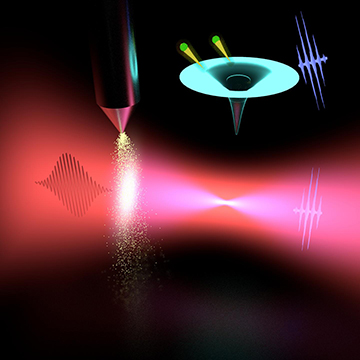
A near-infrared (NIR) pulse (red) is focused and high harmonics are generated in a gas jet that is placed before or behind the NIR focus. In this way, the generated extreme ultraviolet (XUV) light has a size and a divergence that is similar to that of the NIR beam. Due to the shorter wavelength, the focus of the XUV beam is then much smaller than the focus of the NIR beam. This allows the generation of intense XUV pulses that are used for XUV multi-photon ionization of atoms (upper section of diagram). [Image: Balázs Major]
To obtain high-energy, high-intensity pulses in the extreme ultraviolet (XUV) wavelength range, scientists have had to turn to large free-electron lasers or lengthy beamlines. Now researchers from Germany and Hungary have built a compact source of intense XUV pulses based on high-harmonic generation (HHG).
The compact source, which fits on a 2-m-long table, focuses its output radiation to an intensity of 2 × 1014 W/cm2. The researchers tightly focused the near-infrared (NIR) driving laser to generate harmonics several Rayleigh lengths from the NIR focus, thus giving the XUV pulses a beam waist with a radius of only 600 nm (Optica, doi:10.1364/OPTICA.421564).
Changing the HHG approach
“In contrast to other research that we are doing, I feel that the elegance of the current work lies in its simplicity,” says Bernd Schütte, a physicist at the Max Born Institute for Nonlinear Optics and Short Pulse Spectroscopy in Berlin, Germany. “Indeed, the experiments that we have performed could already have been performed two decades ago from a technological point of view.”
In the past, scientists have achieved HHG in a gaseous medium by placing the target jet or cell in the focus of a femtosecond pulsed laser beam. That generates enough intensity (on the order of 1014 W/cm2) to produce XUV radiation. According to Balázs Major of ELI-HU Non-Profit Ltd. and the University of Szeged, both in Hungary, modern laser technology requires long-focal-length optics to perform this feat, leading to long HHG beamlines. (Large synchrotron and free-electron laser facilities use different physical processes, not HHG, to generate XUV beams, Major adds.)
Instead, Major, Schütte and their colleagues used short-focal-length optics and placed the HHG medium, a dense atomic jet, several Rayleigh lengths away from the focus of the driving laser, in a spot where the intensity was at the right level for XUV generation. Major says this approach resulted in a shorter experimental beamline. Also, he says, “the out-of-focus geometry leads to a smaller virtual XUV size which allows for a more intense XUV spot in the experimental target area.”
Future prospects
Schütte says that scientists in almost any laser laboratory could use the new approach because it does not require high-powered lasers and big facilities.
“Although the source does not require the most cutting-edge technology, we believe that it could help to do cutting-edge science in the future,” Schütte says. “Examples are attosecond-pump/attosecond-probe spectroscopy and the coherent diffractive imaging of nanotargets such as biomolecules.”
Schütte and his colleagues plan to use their approach in time-resolved experiments. “While most of the currently performed attosecond experiments use the combination of one attosecond pulse and one femtosecond NIR pulse, the temporal resolution can be improved by using an attosecond pulse both for the pump step and for the probe step,” he says. “Furthermore, disturbing effects from a strong NIR field can be avoided. Using this technique, we plan to study multi-electron correlation dynamics on extremely short timescales.”
